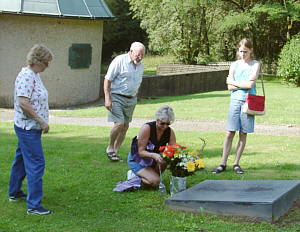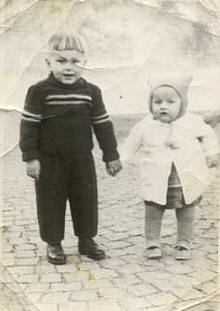|
Janie's and Sofias Return to Wildflecken Translation of the articles published by the "Brükenauer Anzeiger" and the "Main-Post" on Sept. 14, 2002 |
|
Worldwide
known - Wildflecken Article by Heinz Leitsch
Hundreds of children of Polish emigrants, who live today in the USA, Canada, Australia, South America and many European countries, have the name of Wildflecken on their birth certificates. Many of these, who are today in their fifties, may have asked themselves for many years where this mysterious place, Wildflecken, might be? Is it a village, a city, or simply only the name of a camp? Yes, they knew they had been born in a camp in Germany, but often their parents were silent regarding more details of the circumstances. They were busy developing a new life in a new homeland, such as the United States, which was so completely different than war-destroyed Germany or their actual homeland villages in Poland. Some spoke gladly about the Polish homeland, but recruitement to hard labour, employment in German enterprises, and the following stay in the camp were seldom topics of open discussion. Sisters - Janina Micchelli and Sofia Kasperek, both born Suszynski, had for many years no notion where their early years were spent. Sofia had on her birth certificate the entry Wildflecken. Janina was born in Schongau. After the death of their parents only some old photos remained for them. Pictures of snow-covered forests, worn-down buildings which housed groups of people living together; rooms divided only by blankets hung by cords. Was this Wildflecken? Finally some answers would be forthcoming - In February 2001, Janina Micchelli made an internet connection when she typed in the word Wildflecken into the search window of her computer. "When I saw the photos at the site with the name comrades.de, my heart almost stopped." Ms. Micchelli said later. "The buildings pictured here were the same as in the photos my parents had, only in color." An inquiry to the author of the comrades.de site Heinz Leitsch from Modlos confirmed that this indeed was the same place that her parents had lived at for several years. In exchanged e-mail it was learned that the camp was occupied by Polish refugees from 1945-1951, when the U.S. Army took over. Also, that three Suszynski children were born at the camp; Kazimiera, Adam and Sofia. Kazimiera was born in 1946 but lived only 8 months. Nobody knew where her grave was and the circumstances of her death were rather mysterious. Up until the establishment of contact with Mr. Leitsch, the family believed that the parents had been arrested in their native Poland, deported to Germany and enslaved in Wildflecken during and after the war. According to statements of the parents, the infant Kazimiera died as a result of a wrong medication. This then led to the assumption that Nazi physicians might have conducted experiments on the infant, which led to her death. A search of the grave lists gave dates of death and burial, and a visit to the archives produced birth and death records which cleared up this misunderstanding immediately. Kazimiera had died of a seizure and high fever. She was buried in the Polish cemetery at the camp. Nazi physicians were not involved. The UNRRA had been in charge during this time. The burial grounds are still there today, and are very well maintained, often visiting dignitaries come by. This new-found information inspired the sisters to visit Wildflecken. In August 2002, a little over fifty years after they left as toddler and infant, they stepped once again onto German soil. Heinz Leitsch made arrangements for their stay in Bad Brückenau; he then introduced them to Adolf Kreuzpainter, who looks after the Polish cemetery, and Walter Koempel from Oberbach. Walter Koempel is keeper of the chronicle of the municipality Wildflecken, and has helped with the search for birth/death certificates as well as documents when the parents had worked in Oberhof, both had worked for the Forestry Office from June 1944 till May 1945. Walter is still searching for more information on this matter, and has been instrumental in finding the birth/death records for the first born Suszynski child - a boy, Josef, who was born in Oberhof in Thuringen, on September 18, 1944 and died on January 6, 1945 of diptheria. The most moving moments of the visit were when the two sisters were able to lay flowers, and pay their respects at the gave of their sister Kazimiera, who is buried along with 428 other Polish children . "Our family history became a little more completed with the visit to Wildflecken."
Picture: Janina Micchelli lays down a bouquet at the grave of the 428 Polish children, among whom is her sister, Kazimiera,. Left in the picture her sister, Sofia Kasperek, who was born in Camp Wildflecken. |
 Wildflecken
is probably the world-wide most well-known village of Germany. In particular
in the USA millions of former military members connect more or less
good memories with the Rhoengemeinde. But the US military is not the
only group to carry the name of Wildflecken into the world. Before the
Americans made Wildflecken a military base, the former troop-camp of
the German armed forces served as the "Polenlager" (Polish Camp") for
six years. Starting in 1945, thousands of former forced laborers, predominantly
of Polish origin were accommodated here at the end of the war; some
returned to their homeland, others were permitted to emigrate to other
countries.
Wildflecken
is probably the world-wide most well-known village of Germany. In particular
in the USA millions of former military members connect more or less
good memories with the Rhoengemeinde. But the US military is not the
only group to carry the name of Wildflecken into the world. Before the
Americans made Wildflecken a military base, the former troop-camp of
the German armed forces served as the "Polenlager" (Polish Camp") for
six years. Starting in 1945, thousands of former forced laborers, predominantly
of Polish origin were accommodated here at the end of the war; some
returned to their homeland, others were permitted to emigrate to other
countries. At
the beginning of April 1945 the U.S. Army units advanced to troop-camp
Wildflecken. Prisoner statements had obviously fed the opinion that
the camp would be defended by SS-troops. Actually, however, only a few
shots were fired and the use of a bomber squadron considered by the
Americans was not necessary, which is noted in the chronicles of U.S.
involved divisions. When Americans entered the camp only a few buildings
were occupied by wounded German soldiers. The enormous expanse of the
camp drew the attention of the refugee organization UNRRA (United Nation
Relief Rehabilitation Administration) which was looking for urgently
needed accommodations for forced laborers from the formerly occupied
areas, people that had been kidnapped by the Nazis. A goal of the UNRRA
was to collect the Displaced Persons and lead them back to their homelands.
At
the beginning of April 1945 the U.S. Army units advanced to troop-camp
Wildflecken. Prisoner statements had obviously fed the opinion that
the camp would be defended by SS-troops. Actually, however, only a few
shots were fired and the use of a bomber squadron considered by the
Americans was not necessary, which is noted in the chronicles of U.S.
involved divisions. When Americans entered the camp only a few buildings
were occupied by wounded German soldiers. The enormous expanse of the
camp drew the attention of the refugee organization UNRRA (United Nation
Relief Rehabilitation Administration) which was looking for urgently
needed accommodations for forced laborers from the formerly occupied
areas, people that had been kidnapped by the Nazis. A goal of the UNRRA
was to collect the Displaced Persons and lead them back to their homelands.